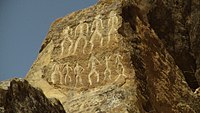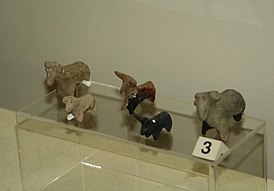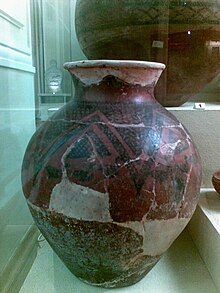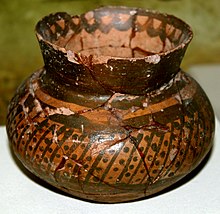
A kurgan is a type of tumulus constructed over a grave, often characterized by containing a single human body along with grave vessels, weapons and horses. Originally in use on the Pontic–Caspian steppe, kurgans spread into much of Central Asia and Eastern, Southeast, Western and Northern Europe during the 3rd millennium BC.

The Kura–Araxes culture was an archaeological culture that existed from about 4000 BC until about 2000 BC, which has traditionally been regarded as the date of its end; in some locations it may have disappeared as early as 2600 or 2700 BC. The earliest evidence for this culture is found on the Ararat plain; it spread north in the Caucasus by 3000 BC.

The Maykop culture, c. 3700 BC–3000 BC, was a major Bronze Age archaeological culture in the western Caucasus region.
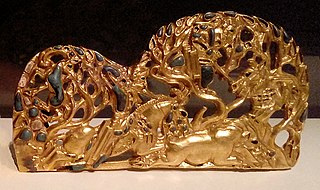
Scytho-Siberian art is the art associated with the cultures of the Scytho-Siberian world, primarily consisting of decorative objects such as jewellery, produced by the nomadic tribes of the Eurasian Steppe, with the western edges of the region vaguely defined by ancient Greeks. The identities of the nomadic peoples of the steppes is often uncertain, and the term "Scythian" should often be taken loosely; the art of nomads much further east than the core Scythian territory exhibits close similarities as well as differences, and terms such as the "Scytho-Siberian world" are often used. Other Eurasian nomad peoples recognised by ancient writers, notably Herodotus, include the Massagetae, Sarmatians, and Saka, the last a name from Persian sources, while ancient Chinese sources speak of the Xiongnu or Hsiung-nu. Modern archaeologists recognise, among others, the Pazyryk, Tagar, and Aldy-Bel cultures, with the furthest east of all, the later Ordos culture a little west of Beijing. The art of these peoples is collectively known as steppes art.

Teppe Hasanlu or Hasanlu Tepe is an archeological site of an ancient city located in northwest Iran, a short distance south of Lake Urmia. The nature of its destruction at the end of the 9th century BC essentially froze one layer of the city in time, providing researchers with extremely well preserved buildings, artifacts, and skeletal remains from the victims and enemy combatants of the attack. The site was likely associated with the Mannaeans.

The Trialeti-Vanadzor culture, previously known as the Trialeti-Kirovakan culture, is named after the Trialeti region of Georgia and the city of Vanadzor, Armenia. It is attributed to the late 3rd and early 2nd millennium BCE. The Trialeti-Vanadzor culture emerged in the areas of the preceding Kura-Araxes culture. Some scholars speculate that it was an Indo-European culture. It developed into the Lchashen-Metsamor culture. It may have also given rise to the Hayasa-Azzi confederation mentioned in Hittite texts, and the Mushki mentioned by the Assyrians.

The Shulaveri–Shomu culture, also known as the Shulaveri-Shomutepe-Aratashen culture, is an archaeological culture that existed on the territory of present-day Georgia, Azerbaijan, and Armenia, as well as parts of northern Iran during the Late Neolithic/Eneolithic. It lasted from around the end of the seventh millennium BC to the beginning of the fifth millennium BC.
The Caucasus region, on the gateway between Southwest Asia, Europe and Central Asia, plays a pivotal role in the peopling of Eurasia, possibly as early as during the Homo erectus expansion to Eurasia, in the Upper Paleolithic peopling of Europe, and again in the re-peopling Mesolithic Europe following the Last Glacial Maximum, and in the expansion associated with the Neolithic Revolution.

Kültəpə is a settlement dating from the Neolithic Age, a village and municipality in the Babek District of Nakhchivan, Azerbaijan. It has a population of 1,859.
Maxta is a village and municipality in the Sharur District of Nakhchivan Autonomous Republic, Azerbaijan. It is located 7 km in the north-west from the district center, on the plain. Its population is busy with vine-growing, farming and animal husbandry. There are secondary school, library, cultural house and a hospital in the village. It has a population of 2,478. A monument was erected in honor of the compatriots killed in The Great Patriotic War (1941–45). In the north-east of the village, on the right side of the Nakhchivan-Sadarak highway is located the Qarabulaq necropolis of the Iron Age, and on the left side is located the ancient necropolis of Maxta. The municipality consists of the villages of Maxta and Təzəkənd.
Dizə is a village and municipality in the Sharur District of Nakhchivan Autonomous Republic, Azerbaijan. It is located on the left bank of the river Arpachay (Arpa), on the Sharur plain. On the other side of the river is the village of Oglanqala.
Archeological sites in Azerbaijan first gained public interest in the mid-19th century and were reported by European travellers.

The Leyla-Tepe culture of the South Caucasus belongs to the Chalcolithic era. It got its name from the site in the Agdam District of modern-day Azerbaijan. Its settlements were distributed on the southern slopes of Central Caucasus, from 4350 until 4000 B.C.

Martkopi is a village in Gardabani Municipality of Georgia. It is located on the left side of Ialno range, in the gorges of the rivers Alikhevi and Tevali, and is at an altitude of 770 meters. It is 55 kilometres from Gardabani and 12 kilometres from Vaziani. According to 2014 census, the village is populated by 7397 residents.
Kul Tepe Jolfa is an ancient archaeological site in the Jolfa County of Iran, located in the city of Hadishahr, about 10 km south from the Araxes River.
Stone Age in Azerbaijan is divided into the Paleolithic, Mesolithic, and Neolithic periods. It was studied in Karabakh, Gazakh, Lerik, Gobustan, and Nakhchivan. Stone materials belonging to the Stone Age were found by Mammadali Huseynov in the Shorsu gorge located near the village of Gyrag Kasaman in Qazakh region. According to his research, people have first settled in the territory of Azerbaijan 2 million years ago. The Stone Age era involved two different human species: Homo neanderthalensis and Homo sapiens.

The Nakhchivan culture, also known as the Kizilveng culture or Painted Pottery culture, was formed during the Middle Bronze Age in the 3rd and 2nd millennium BC. The main center of painted pottery were Nakhchivan and the Arpachay Valley, in Anatolia, Urmia lake basin and the South Caucasus. In Azerbaijan, this culture was studied on the basis of archeological materials from the I Kultepe, II Kultepe, Shahtakhti, Gizilburun, Nahjir, Shortepe, Garachuk, II Gazanchi qala and other monuments. The painted pottery culture was studied by Azerbaijani archaeologists such as O. Habibullayev, V. Bakhshaliyev, V. Aliyev and A. Akbarov. According to V. Bakhshaliyev, the formation of this culture dishes in Nakhchivan was connected with the formation of the city states.
Uçan ağıl is an archaeological site north of Sirab village in Babek District of Nakhchivan Autonomous Republic, Azerbaijan. It is located at the altitude of 1200 m a.s.l. in the Sirab piedmonts, in the upper reaches of Sirab Suyu river along with other sites from the same period, Sorsu, and Zirinclik. It is dated at ca 4850-4350 BC time span, but was also occupied in the 3rd millennium BC. Uçan Ağıl was likely used by mobile pastoralists on a seasonal basis. They mostly pastured herds of goats.
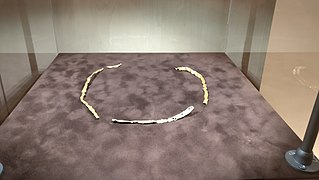
Ovçular Tepesi is an ancient settlement located at the northern end of Dizə, Sharur village in Sharur District of Azerbaijan, on the left bank of Arpa (river). It dates back to the fifth millennium BC, and continued to the third millenniums BC.
Galayeri is an important archaeological site of the Chalcolithic era located in the Qabala District of Azerbaijan. It belongs to the Leyla-Tepe culture.
